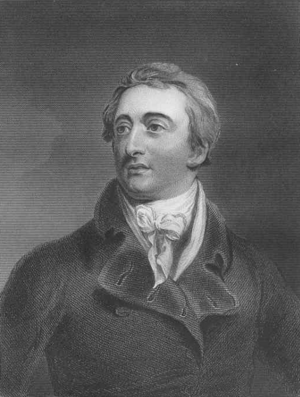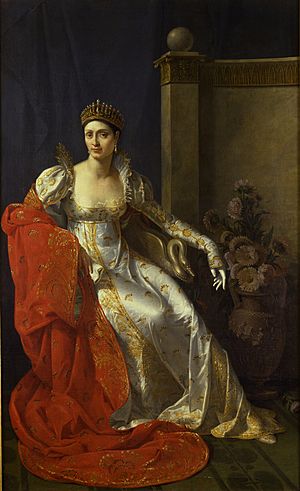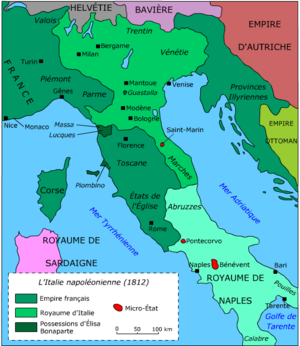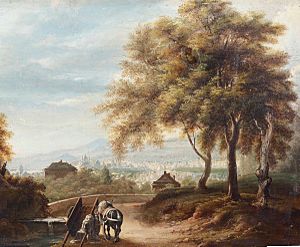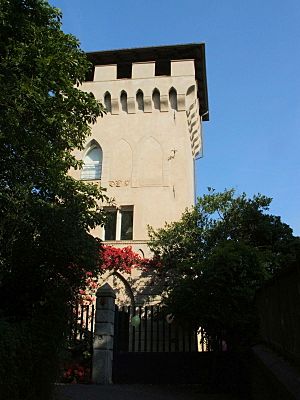Siege of Genoa (1814) facts for kids
Quick facts for kids Siege of Genoa (1814) |
|||||||
|---|---|---|---|---|---|---|---|
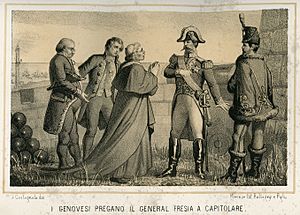 The Genoese entreat General Fresia to capitulate to the Allies |
|||||||
|
|||||||
| Belligerents | |||||||
| Commanders and leaders | |||||||
| Strength | |||||||
| 16,000–18,000 soldiers 7 frigates 12–15 brigantines |
A few thousand soldiers | ||||||
The siege of Genoa happened from April 13 to 18, 1814. It was a battle where a British and Sicilian army captured the port city of Genoa from the French Empire. This event was the very last battle of the Sixth Coalition's campaign in Italy. Just a few days before, on April 4, Napoleon had given up his title as emperor of France.
British and Sicilian forces, led by Lieutenant General William Bentinck, surrounded Genoa. Meanwhile, Austrian forces took control of Lombardy, which was part of the Kingdom of Italy created by Napoleon. After the siege, a short-lived Republic of Genoa was announced. However, this republic was soon ended by the Congress of Vienna. Genoa was then given to the restored Kingdom of Sardinia.
Contents
How the Conflict Started
In early 1814, British General William Bentinck sailed from Sicily. His goal was to join the fight against Napoleon's forces in Italy. He first stopped in Naples. There, he made a deal with Joachim Murat, who was Napoleon's brother-in-law and the king of Naples. Bentinck didn't like Murat, but Britain wanted Murat to switch sides and join the fight against Napoleon. In return, Murat's kingdom would be safe.
Bentinck then ordered his troops to land at Livorno. He traveled north to meet them. The landing took three days, starting on March 9. Murat's Neapolitan troops had already taken control of the port.
Napoleon's sister, Elisa, was also in Italy. She was the princess of Tuscany. She tried to save some of her power as her brother's empire collapsed. Elisa had a deal with Murat to keep her small territory, the Principality of Lucca and Piombino. This was in exchange for giving up Tuscany without a fight.
When Bentinck arrived in Livorno, Elisa sent people to ask if her deal with Murat would be honored. Bentinck said no. He told her to leave immediately or she would be arrested. Bentinck sent 2,000 British troops towards her city. Elisa, who was pregnant, had to flee north. She was later captured by the allied forces.
After Elisa left, Bentinck made a public announcement from Livorno on March 14. He called on the Italian people to rise up and fight for their freedom from Napoleon. He said Britain was there to help them. Bentinck dreamed of an independent Italian nation in the north and center. However, this idea went against what his own British government wanted. The government planned to put things back to how they were before Napoleon. This meant Austria would control Lombardy, and the King of Sardinia would rule Piedmont.
For about a month, Bentinck acted mostly on his own. He believed he was doing what was best for Britain, even if his government didn't agree. He ordered his troops to head north to attack Genoa. Bentinck himself went to meet Murat again. At this meeting, Bentinck demanded that Tuscany be given to him. He argued he needed it as a base for his military operations. Murat refused, saying he needed it for his own forces. Bentinck then threatened to attack Naples itself. However, he quickly received a strong message from his government. They reminded him to work with Murat and Austria. Bentinck then gave up his demand for Tuscany and left for Genoa. He had hoped to make Tuscany the start of a free Italian state. The people of Tuscany had not responded to his call for rebellion. But in Genoa, he would find people who welcomed his ideas.
Bentinck had been ordered to capture Genoa for the King of Sardinia, Victor Emmanuel I.
The Battle for Genoa
Approaching the City
On April 9, General Jean Pégot was sent to Genoa to take command of the French forces there. On the same day, the town of Recco was heavily bombed by the Coalition forces. The next day, the bombing continued, forcing French ships to leave.
General Pégot learned that Austrian troops had joined local rebels. He also saw that the British kept firing on Recco and Sori. So, he decided to move his troops during the night of April 9. The French retreated in an orderly way. By the morning of April 10, Pégot's forces were positioned at Monte Fasce.
The Coalition had many warships and transport ships off the coast of Genoa. The French saw them moving towards Savona. This made the French worry about a landing on the beach near Sampierdarena. This beach was only guarded by a few French detachments.
On April 12, the Coalition attacked Pégot at Monte Fasce. They fought all day. But General Pégot found it impossible to hold his position. He pulled his troops back during the night. He moved them to Sturla, on the heights of Albaro. His right flank was protected by the sea and a battery of four cannons. His left flank was near Fort Richelieu.
The Siege Begins
Coalition forces reached the walls of Genoa on April 13. Bentinck led the British troops, and General Vito Nunziante commanded the Sicilians. The main fighting happened around Sturla and Albaro. The British were getting ready for a big attack there.
That day, the allies landed at Nervi with soldiers, cannons, and cavalry. They attacked the Sturla position. At first, the French gunners at Sturla fired on them but then left their posts. General Pégot brought them back and ordered them to fire again. Pégot was wounded in this fight. General Jean-Pierre Piat took his place. The fighting continued all day on the Albaro heights. By evening, Coalition howitzers destroyed the Sturla battery.
On April 14, the British attacked Albaro again. Bentinck himself was there. He had sent a message to the people of Genoa, saying he would be inside the city the next day. He was confident because his forces were much stronger. This news caused some unrest in the city. General Fresia, the French commander, asked the city's local guard, the Garde Nationale, to help keep order.
On April 17, at 2 AM, the British launched a fake attack between Sestri Ponente and Sampierdarena, supported by artillery fire. At 5 AM, they started firing on the French battery to the left of Sturla. The Coalition ships moved closer to the coast. They attacked the San Martino and San Francesco positions with over 15,000 men. The French troops were forced to leave their positions. They also had to abandon the area between the Richelieu, Santa Tecla, and Sperone forts.
The cannons at the Torre dell'Amore were captured from behind. The Coalition then began bombing the city. This made the people of Genoa rebel against the French. The mayor and archbishop Giuseppe Spina went to General Fresia. They urged him to surrender. Fresia allowed the city officials to send a group to Bentinck. They asked him to stop the bombing. Bentinck refused. He demanded that the city be handed over, along with the forts of Santa Tecla and Richelieu. The French troops then retreated in good order behind the Bisagno River. The British did not advance past San Martino d'Albaro.
The unrest in the city grew throughout April 17 and into the night. The local guard did not try to calm things down. The next day, the French forces inside the city surrendered.
On April 18, around noon, Bentinck sent Lieutenant General Robert Henry MacFarlane to speed up the surrender. He threatened to restart attacks and bombings if they refused. The day was spent in talks. That night, the agreement for the French to leave was signed. On April 20, the British entered the city. General Fresia was allowed to leave Genoa with military honors.
What Happened Next
When Genoa surrendered on April 18, 1814, Bentinck did something unexpected. He announced that the Republic of Genoa would be restored. He also canceled all laws passed since 1797. This was against what the Coalition (the allied powers) wanted. The people of Genoa were very excited by this. At the same time, Bentinck sent a small army to Corsica. He hoped to bring back the Anglo-Corsican Kingdom that had existed briefly before. This would give Britain another useful base in the Mediterranean.
In Genoa, on April 24, Bentinck met with representatives from the temporary government in Milan. They asked Britain to support an independent Kingdom of Italy. They did not want Austria to rule Lombardy again. Napoleon had given up his French and Italian thrones on April 11. So, the Milan government was looking for a new ruler who could help their kingdom survive. They even suggested that Prince Adolphus, Duke of Cambridge, a son of King George III, would be a good choice. Bentinck, however, suggested Archduke Francis of Este as a more realistic option to please the Austrians.
However, news of Napoleon's abdication on April 11 slowly reached Italy. This greatly reduced Bentinck's ability to influence events. The war was ending, and his government's patience with his independent actions ran out. The British Prime Minister, Lord Liverpool, even called Bentinck "mad." Bentinck's authority was sharply reduced. He was finally removed from his position as Commander-in-Chief in the Mediterranean the following April.
Related items
- Fall of the Kingdom of Italy
- 1st Regiment Greek Light Infantry
- Siege of Genoa (1800)
- it:Cattura di La Spezia
- it:John Rosselli
- it:Italian Levy
- it:Calabrian Free Corps


